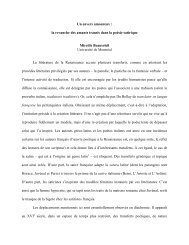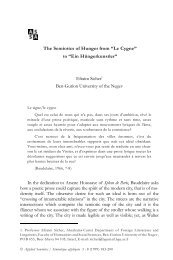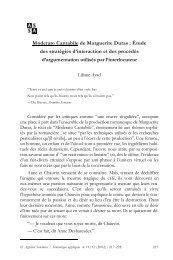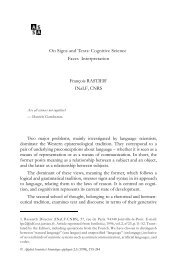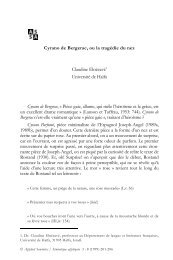“Beannacht libh, cried Miss Ivors” Translating James Joyce: Culture ...
“Beannacht libh, cried Miss Ivors” Translating James Joyce: Culture ...
“Beannacht libh, cried Miss Ivors” Translating James Joyce: Culture ...
You also want an ePaper? Increase the reach of your titles
YUMPU automatically turns print PDFs into web optimized ePapers that Google loves.
theoretical considerations but rather personal ones when they decide whether or not they need to<br />
clarify a CSI.<br />
The second observation of this comparative analysis is the fact that translators vacillate<br />
over the use of domestication or foreignization tools. It seems that during the translation process<br />
translators are influenced by both domestication and foreignization strategies. This sometimes<br />
leads them to make conflicting translation choices. For instance, Fernandez borrows the title<br />
“<strong>Miss</strong>” but uses “M.”, the French abbreviation of Monsieur, rather than retaining the “Mr.” which<br />
would have made her translation strategy consistent. Similarly, after choosing an extremely<br />
foreignizing strategy when borrowing <strong>“Beannacht</strong> <strong>libh</strong>”, she chooses a domestication tool called<br />
equivalence when translating “the palace of the Four Courts”. She completely erases the Dublin<br />
specificity of the source text by solely conveying the functional aspect of the CSI: “le palais de<br />
justice”. Aubert oscillates between domestication and foreignization too. He favors foreignization<br />
when he borrows the expression “innocent Amy” and then domestication when he adapts the CSI<br />
“West Briton” by transposing it to a French perspective: “Angliche”. It appears that translators do<br />
not favor one strategy over the other. Initially, it seemed that a translator would chose to use<br />
either a strategy of foreignization or a strategy of domestication, but it is not the case in practice.<br />
A translator’s strategic position is therefore not globally pragmatic but occurrence-based.<br />
Although the translators’ position between domestication and foreignization changes<br />
constantly, it is clear that the tool they use the most is a foreignizing tool called borrowing. In<br />
general, translators seem to try to retain the cultural specificity of the source text (“innocent<br />
Amy”, <strong>“Beannacht</strong> <strong>libh</strong>”, “Four Courts”, “O’Connell Bridge”, “Daily Express”, “Dan”) even<br />
though it often implies a high level of entropy. The examples quoted above show that borrowings<br />
have the advantage of rooting the target text in the source culture by introducing a touch of local<br />
color. Unfortunately, as with Fernandez’s borrowing of <strong>“Beannacht</strong> <strong>libh</strong>”, translators risk<br />
14





